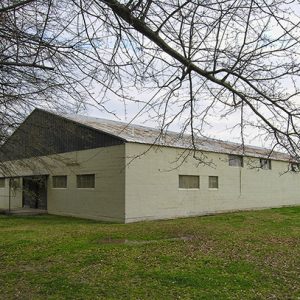calsfoundation@cals.org
Carver Gymnasium
The Carver Gymnasium, located at 400 Ferguson Street in Lonoke (Lonoke County), is the last remaining structure associated with the town’s first African American school. The plain-traditional-style concrete block construction building was added to the National Register on September 23, 2009, under Criterion A, due to its significance to local Black history.
In 1889, Goodspeed’s history documented that Lonoke was home to two schools, one for white students and one for “colored people.” A total of 1,640 Black students were recorded in the county. The Black school consisted of a two-story frame structure. It provided educational opportunities for grades one through eight. Attendance was sporadic due to the vast majority of students living and working on farms.
In the fall of 1889, Professor William H. Pettus, a major influence in the early growth of the school, began teaching there. Under his direction, students were required to complete the eighth grade twice. Sometime by the early twentieth century the school building was determined to be unsafe for occupation. The school was moved to the Masonic Lodge at 600 Ferguson Street, where it remained for a number of years.
Between 1917 and 1925, a movement to improve African American education was led by the Rosenwald Fund. A total of $2,700 was provided to Lonoke County for the establishment of five additional African American schools. During the Great Depression, a new two-room school building was constructed in Lonoke, with funding provided by the Works Progress Administration (WPA).
In 1945, Professor F. T. Bunton was hired as the first principal of the Lonoke Colored School. He would remain until 1966. Under his motto, “education is the road to success,” the school continued to improve, with the curriculum being expanded to twelve grades. The first class graduated in 1950.
In 1946, the school was renamed George Washington Carver High School in honor of the Black scientist and inventor. By the early 1950s, all of the Lonoke County African American schools were consolidated with Carver. This caused difficulties for many students due to lack of transportation. The school was also burdened with a lack of supplies and books, as well as overcrowding. The situation worsened in 1952 when the school burned. While a new building was under construction, classes were held in the basement of the St. Paul Baptist Church. A new two-story brick building was completed by 1954.
The gymnasium was constructed in 1957. It quickly became a center of activity for the Black community. School assemblies, sporting events, and community gatherings were held in the gym for the next forty-eight years. When the county schools were integrated in 1970, the school campus was designated Lonoke Junior High School.
By the early twenty-first century, the campus had become outdated. In 2005, the campus was vacated by the school district. Soon the gym was all that remained of the school. After the closing of the school, the George Washington Carver Alumni association, which was formed in 1950 and incorporated in 2004, requested that the school donate the gym and area to the association. On March 30, 2008, the school administration deeded the building and five lots to the association to be used as a multicultural center.
In 2010, the alumni association received a $23,333 grant from the Arkansas Historic Preservation Program for the restoration of the building. In the twenty-first century, the Carver Tiger’s Multicultural Center provides a variety of activities for local youth, including recreation, tutoring, and mentoring. The building is also used for community activities.
For additional information:
Biographical and Historical Memoirs of Central Arkansas. Chicago: Goodspeed Publishing Co., 1890.
“Carver Gymnasium.” National Register of Historic Places registration form. On file at Arkansas Historic Preservation Program, Little Rock, Arkansas. Online at https://www.arkansasheritage.com/arkansas-historic-preservation-program (accessed November 15, 2024).
Dodson, Aretha. That’s the Way It “Wuz” Back Then: A Recollection of Events, Stories, and More. Bloomington, IN: Westbow Press, 2014.
Mike Polston
CALS Encyclopedia of Arkansas


 Carver Gym
Carver Gym 



Comments
No comments on this entry yet.